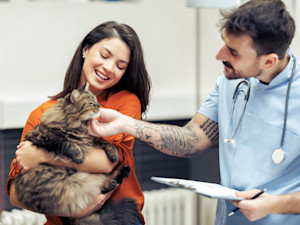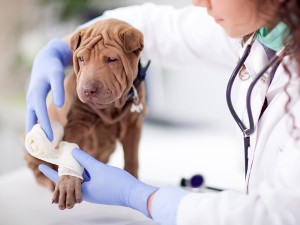What Does Pet Insurance Not Cover? Exclusions Explained
How to avoid surprise bills by knowing exactly what is not covered by your policy.
In This Article:
Understanding Pet Insurance and Exclusions Common Exclusions in Pet Insurance Other Possible Exclusions How to Review and Compare Policies Tips for Minimizing Uncovered Expenses
Buying pet insurance means that you won’t have to shoulder the full cost of an unexpected illness or injury. It’s a smart move that helps you focus on your pet’s recovery instead of your bank account.
However, as helpful as it is, pet insurance policies don’t cover everything. Like any insurance policy, pet insurance comes with exclusions — specific things that aren’t included under your plan. Knowing what’s not covered can help you avoid surprise bills and choose a policy that makes sense for your pet’s needs and your budget.
How much do you spend on your pet per year?
Understanding pet insurance and exclusions
Before we dive into the details of what’s excluded, it’s important to understand how pet insurance coverage works in general.
Most pet insurance companies reimburse you for eligible vet bills related to accidents, diseases, injuries, or illnesses after you’ve met your deductible. You choose the type of plan, deductible, coverage level, and reimbursement rate that fit your needs.
However, not all treatments or conditions qualify for reimbursement. Each provider has its own list of exclusions, which outlines the things the policy won’t pay for. You’ll find these details in the policy documents, usually under either the “what’s not covered” section or the “policy exclusions” section.
Understanding these terms can get confusing, especially since some insurers define preexisting conditions differently or are vague about specific treatments. Not up on insurance terms? Check out our Pet Insurance Glossary for help understanding the fine print.
Common exclusions in pet insurance
Most pet insurance plans exclude specific treatments or situations for one simple reason: They’re considered predictable, preventable, or non-essential from a medical standpoint. Let’s go through the most common ones.
Preexisting conditions
A preexisting condition is any illness or injury your pet had before your policy’s start date or during its waiting period (the time between when you enroll and when your coverage begins).
Examples include chronic issues such as diabetes, allergies, arthritis, or recurring ear infections that started before coverage. Once something is labeled “preexisting,” any future claims related to it are usually denied.
That said, some pet insurance providers distinguish between “curable” and “incurable” preexisting conditions. For example, if your dog had a respiratory infection that was treated and hasn’t recurred for a year, some insurers might cover it again after a symptom-free period.
The best way to avoid this limitation is to enroll your pet while they’re young and healthy. Waiting until after a health issue shows up can make it impossible to find coverage for that particular condition.
Elective procedures
Elective procedures are surgeries or treatments that aren’t medically necessary. They’re considered optional, and pet insurance companies rarely cover them.
Common examples include:
Tail docking or ear cropping
Nail trims
Declawing
Cosmetic dental cleanings
Spaying or neutering (unless you have a wellness add-on)
Even though spaying and neutering have long-term health benefits, they’re still classified as elective without specific preventive-care coverage.
If you’re curious about which procedures are covered, our guide to what pet insurance covers offers a clear breakdown of what most insurers include.
Routine and preventive care
Routine and preventive care (the everyday stuff that keeps your pet healthy) usually isn’t covered under a standard pet insurance policy.
That includes:
Annual checkups
Vaccinations
Flea, tick, and heartworm prevention
Blood tests and lab work for wellness exams
Dental cleanings for healthy teeth
To get coverage for these expenses, you’ll need to add a wellness or preventive-care plan to your policy. These add-ons can offset annual vet costs, but are optional.
Genetic or congenital conditions
Some pet insurance companies won’t cover conditions that are inherited or present from birth. Some of these include:
Hip dysplasia in large breeds
Heart defects
Patellar luxation
Cataracts
These conditions can be expensive to treat, so it’s important to check if your chosen provider covers them. Many newer insurers do, but only if symptoms appear after the policy starts.
For example, if your Labrador develops hip dysplasia two years into coverage, it may be reimbursable. But if your vet noted early signs before your plan began, it likely won’t be.
Breed-specific conditions
Some dog and cat breeds are more susceptible to certain health conditions, and some pet insurance plans exclude or limit coverage for those conditions.
Examples:
Bulldogs and Pugs: Brachycephalic (breathing) problems
Dachshunds: Spinal disc injuries
German Shepherds: Hip and joint problems
Dobermans: Heart conditions
Breed-based exclusions can be frustrating, but they’re often based on data showing how frequently these conditions occur. When comparing plans, make sure you understand if the insurers set limits based on your pet’s breed.
Other possible exclusions
Beyond the common exclusions, you’ll find other treatments or circumstances that might not be covered, depending on the insurance company and plan you choose.
Behavioral treatments
Behavioral issues such as separation anxiety or obsessive chewing are usually excluded from standard coverage. That’s because they’re not considered medical illnesses.
That said, some pet insurance providers do include limited behavioral-therapy benefits, but only if a vet prescribes it. If your dog or cat needs professional behavior modification, it’s worth confirming whether or not your plan supports this kind of care.
Alternative and holistic therapies
Treatments such as acupuncture, chiropractic adjustments, hydrotherapy, or herbal medicine may or may not be covered.
Some pet insurance companies consider these to be experimental or complementary, which means they’re excluded. Others include them under premium or comprehensive plans if recommended by a licensed vet.
Occupational hazards
If your pet does work (such as therapy work or even professional show competitions), your insurance policy might exclude injuries related to that job.
Let’s say a police K9 or a herding dog is injured while working — standard pet insurance usually won’t cover it. Specialized working-dog insurance might be required for those situations.
Training and socialization
Getting your pet accustomed to being around others is important, but training is not covered under pet insurance. That includes obedience training, puppy kindergarten, or professional agility classes.
Even if a vet recommends training to address behavioral problems, most pet insurance plans still categorize it as non-medical.
How to review and compare policies
Each pet insurance company sets its own rules about what’s covered and what’s excluded. Reading the fine print is central to making an informed decision and avoiding unwanted surprises.
Check the exclusions section: Every policy lists what it doesn’t cover, and that list is usually longer than the coverage list.
Check the waiting period: Some plans exclude illnesses or injuries that happen when the policy is new (like in the first 14 or 30 days).
Look for optional add-ons: Wellness plans or chronic-care riders can fill in where your regular insurance plan falls short.
Ask questions: If you’re not clear on something, ask. If the insurer won’t clarify, that’s your sign to avoid them.
Compare multiple providers: Don’t assume all pet insurance policies cover the same things. Compare plans to find one that fits your budget and your pet’s health needs.
It’s also smart to keep a copy of your pet’s medical records handy. That way, if there’s ever a dispute over whether a condition was preexisting, you’ll have documentation ready.
Tips for minimizing uncovered expenses
Even with exclusions, there are ways to reduce how much you spend on out-of-pocket vet bills.
Enroll early: The younger your pet is when you sign up, the fewer preexisting conditions they will have.
Keep up with preventative care: Ongoing checkups help catch things before they become major, uninsured problems.
Review your plan every year: As your pet ages, their risk factors change, and so do your coverage options and costs.
Budget for non-covered care: Set aside money every month for grooming and preventive meds.
Consider supplemental coverage: Some insurers offer wellness riders for vaccines, dental cleanings, supplements, and checkups.
Although you can’t eliminate exclusions, being proactive helps you manage costs more predictably.
Bottom line
Most plans won’t pay for preexisting conditions, conditions your pet’s breed is prone to, elective procedures, or routine preventive care. Coverage for things such as behavioral therapy or alternative treatments varies by provider, too.
Before you enroll, take time to read the fine print, compare multiple pet insurance plans, and understand exactly what your coverage includes and what it doesn’t. That way, you’ll know what to expect if your dog or cat needs care.
In the end, pet insurance is still one of the best tools for protecting your budget against surprise vet bills. Just make sure you’re buying the kind of coverage that fits your pet’s life and your expectations.
References
American Veterinary Medical Association (AVMA). “Do You Need Pet Insurance?” www.avma.org/resources-tools/pet-owners/petcare/do-you-need-pet-insuranceopens in new tab.
CBS News. “This Is What Pet Insurance Does and Doesn’t Cover.” www.cbsnews.com/news/what-pet-insurance-does-and-doesnt-coveropens in new tab.
GoodRx Health. “What Does Pet Insurance Not Cover?” www.goodrx.com/pet-health/pets/what-does-pet-insurance-not-coveropens in new tab.
North American Pet Health Insurance Association (NAPHIA). “State of the Industry Report 2025.” naphia.org/industry-dataopens in new tab.
Pumpkin Pet Insurance. “Exclusions in Pet Insurance Explained.” www.pumpkin.care/post/exclusions-in-pet-insuranceopens in new tab.










